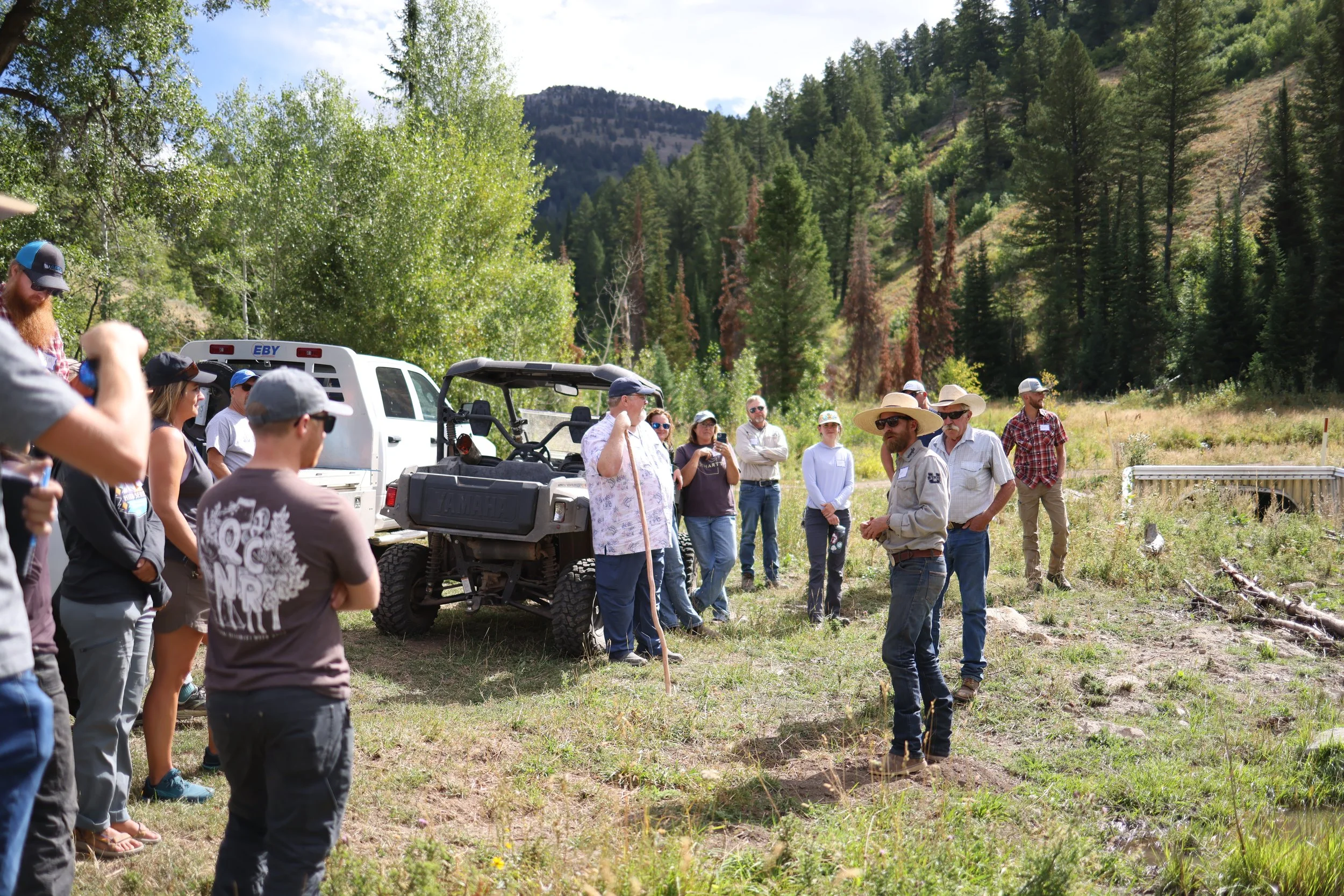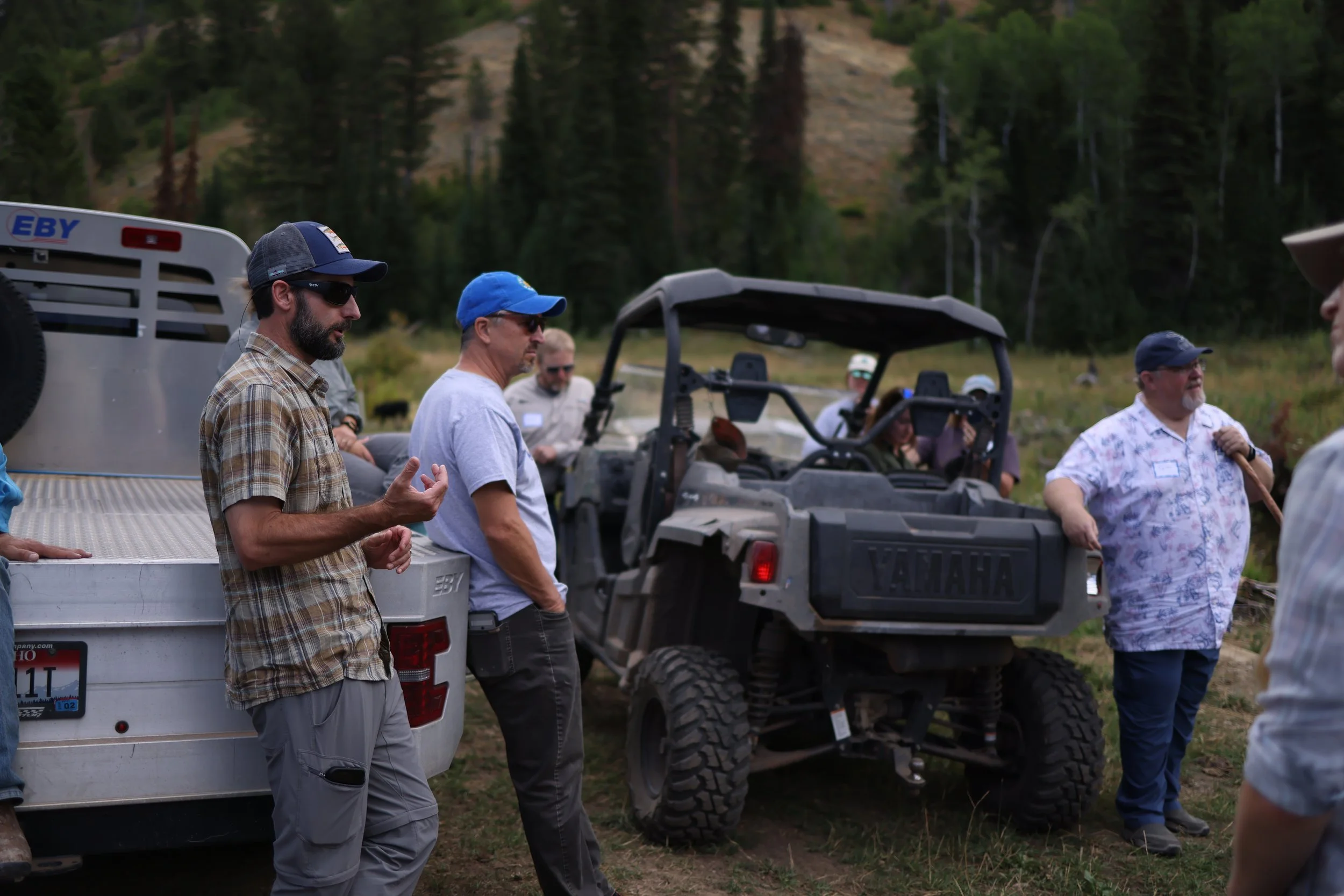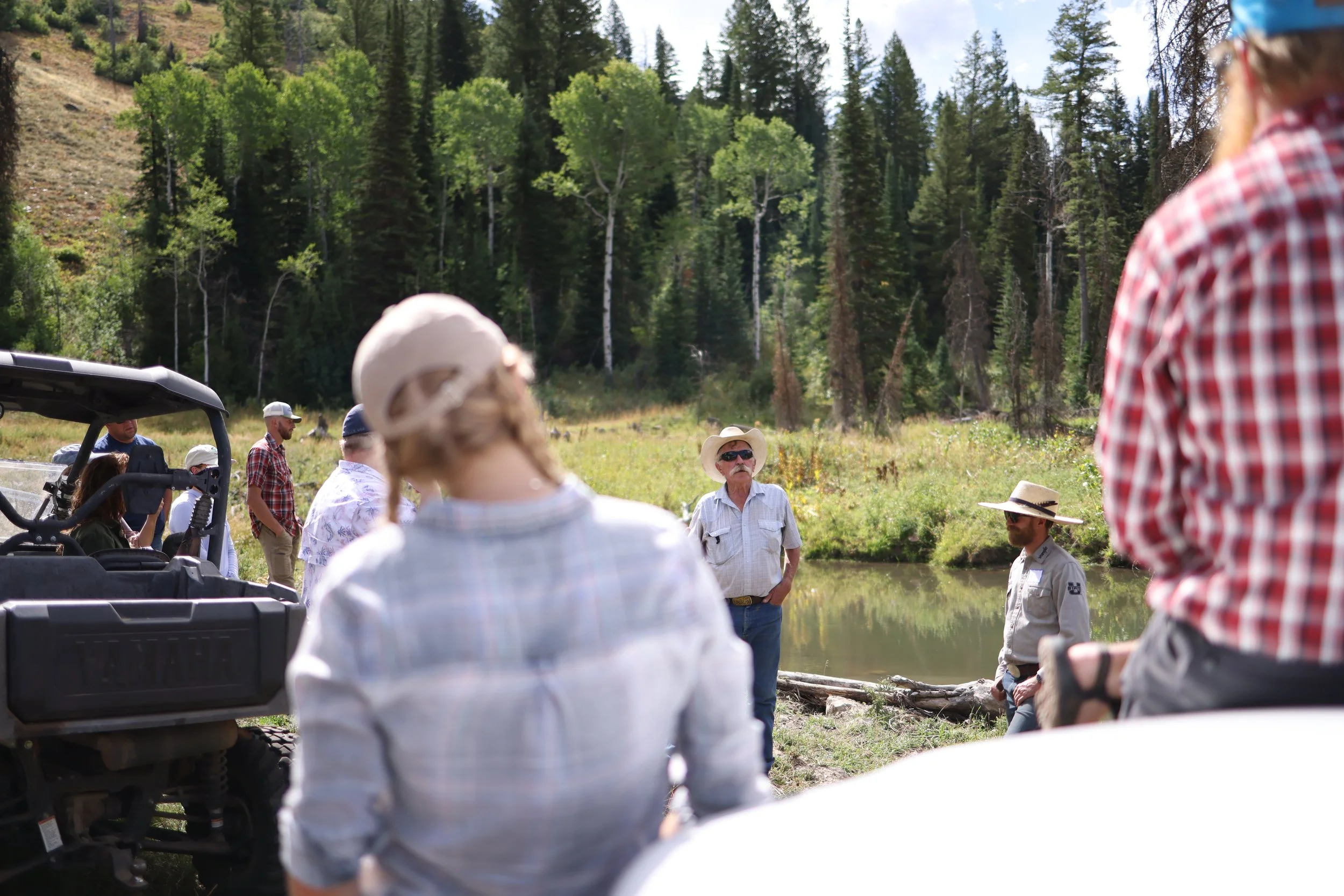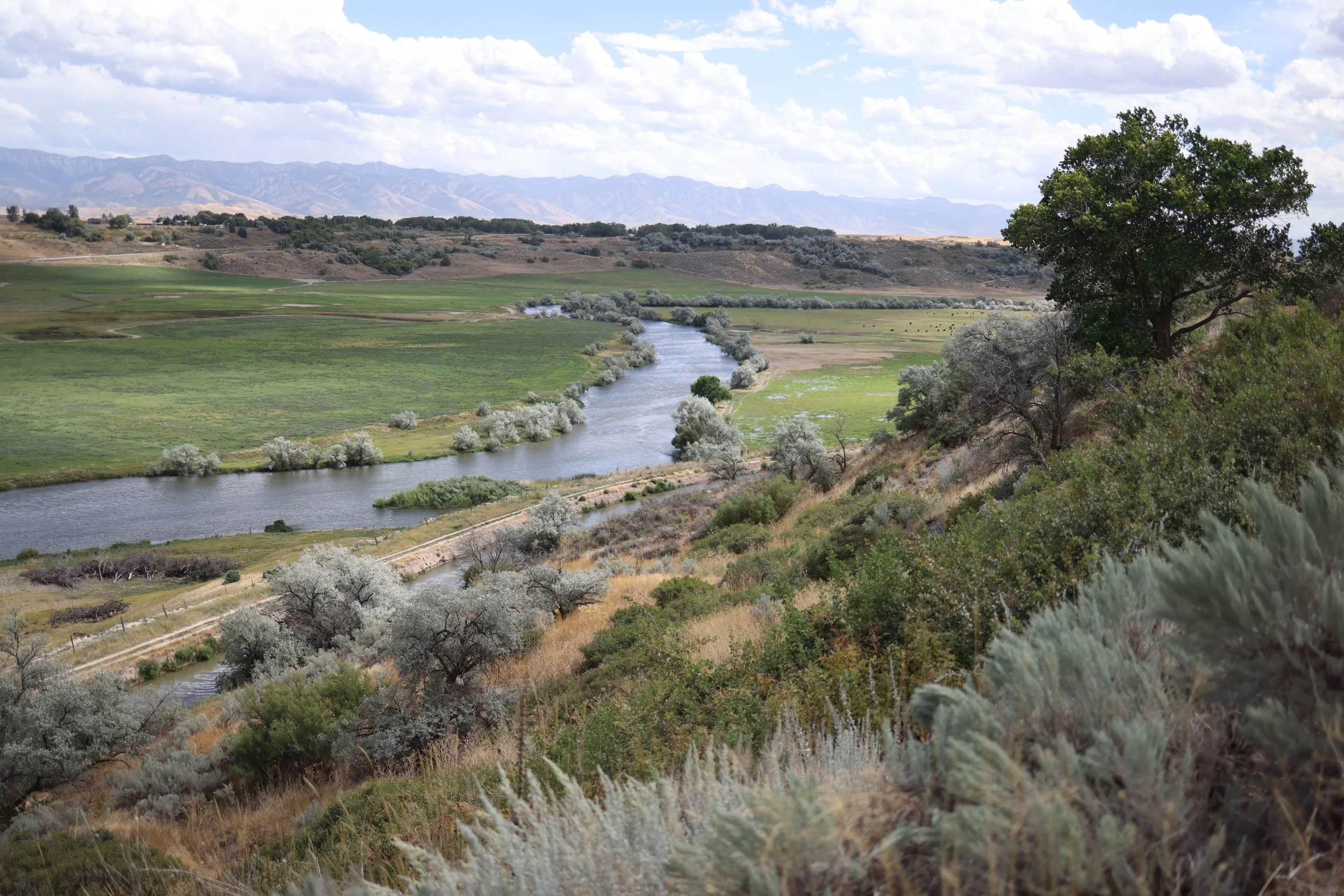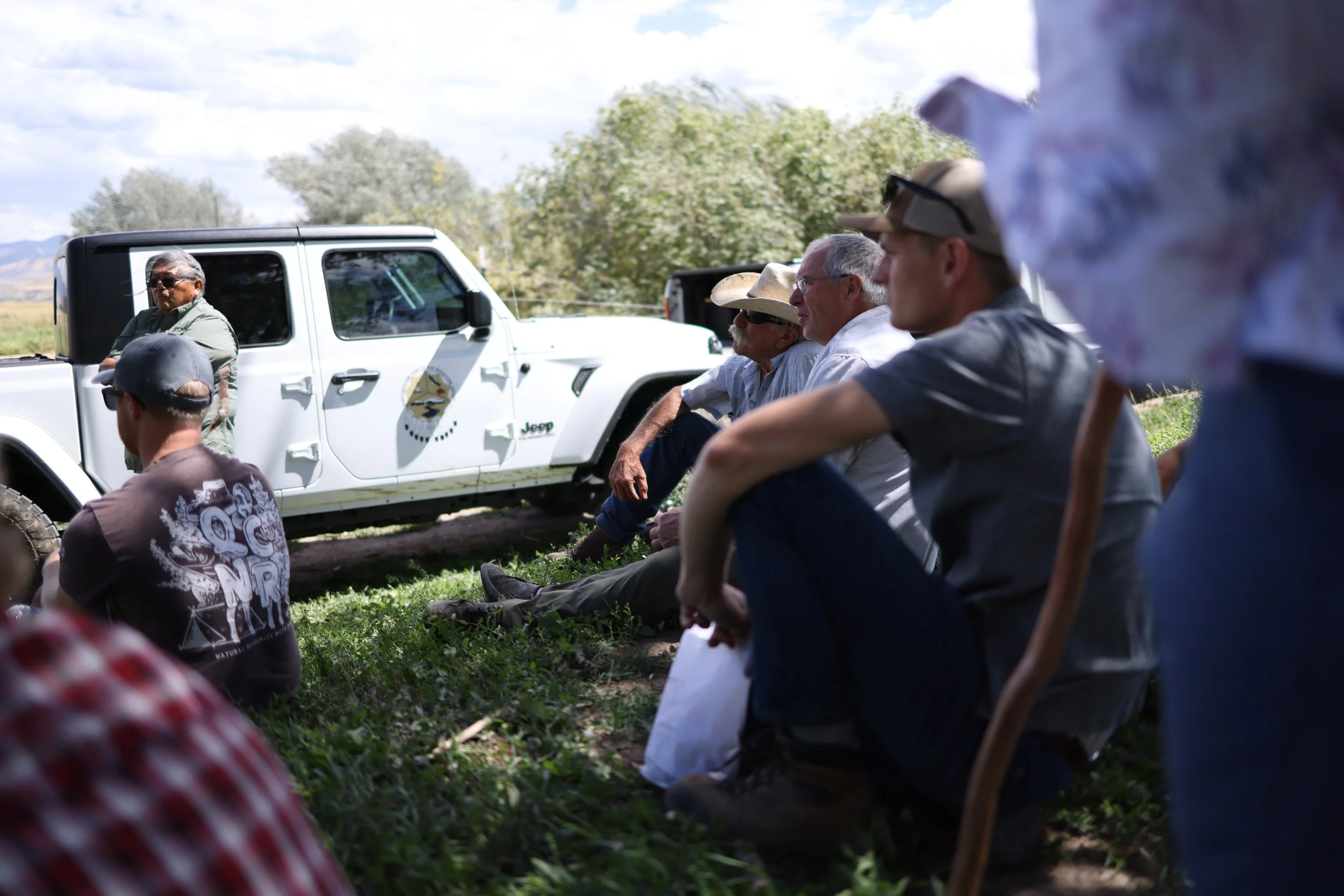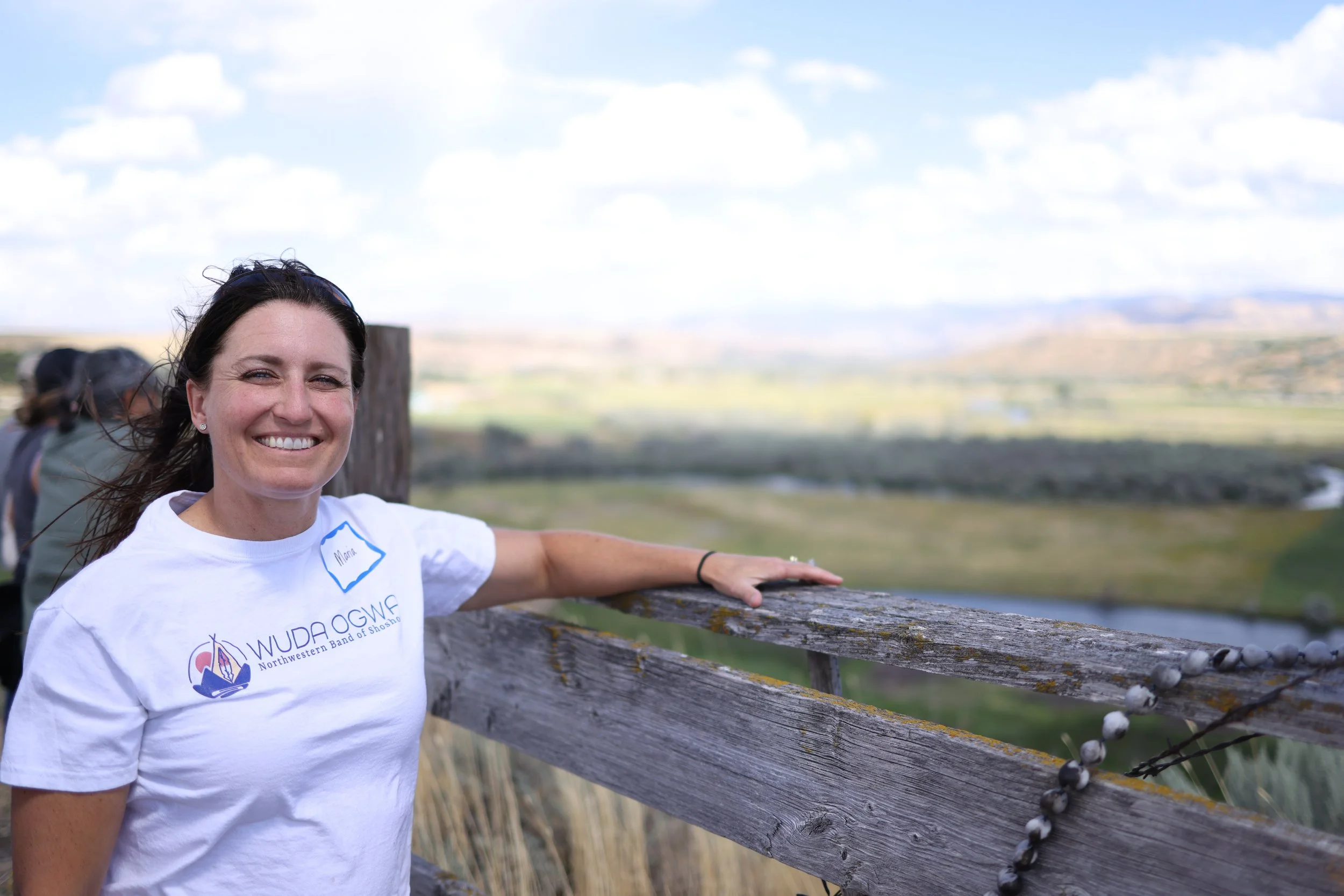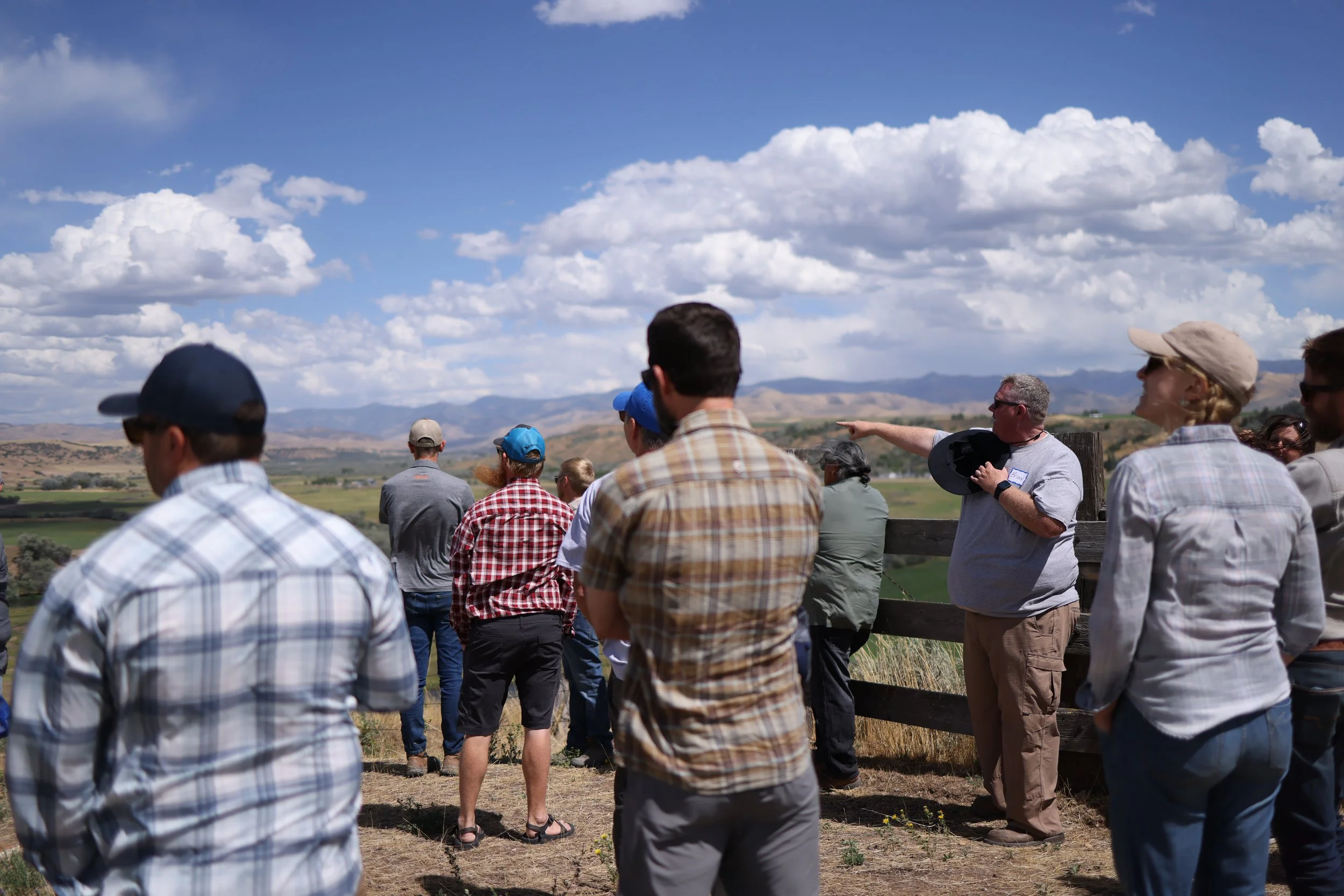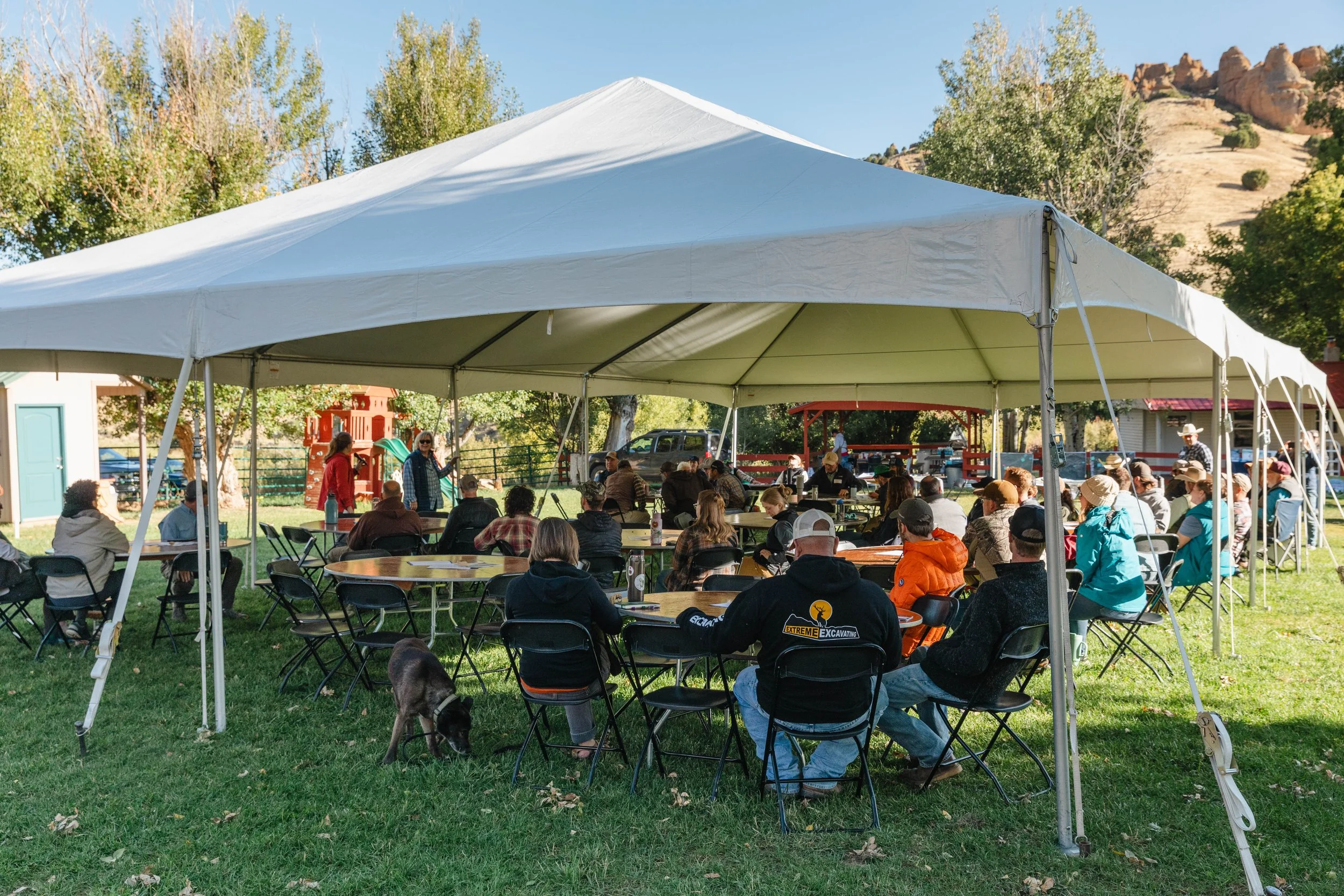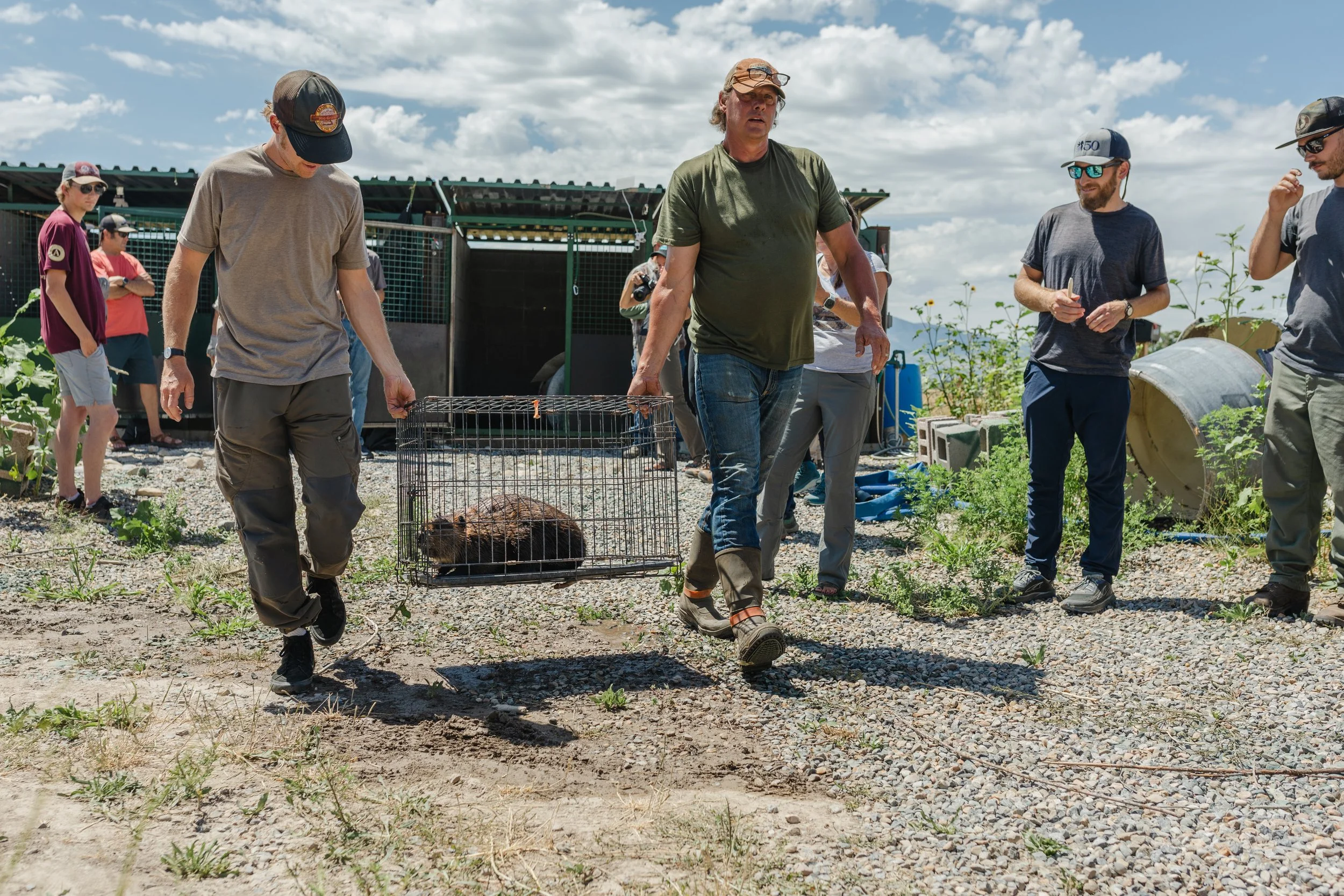Weaving Communities Together to Heal Western Watersheds
Life teems at the edge of a beaver pond as a group gathers to discuss watershed restoration. Photo: Janice Gardner
By 10am, the sun already sat high in the sky as an unlikely group gathered at the edge of a large beaver pond in southeastern Idaho.
Tucked in a shady valley along Birch Creek, restoration practitioners, ranchers, scientists, land managers, and Indigenous leaders came together to share stories and options for restoration in the Bear River watershed. For a few moments after stepping out of vehicles, the group fell silent, observing the beaver-built oasis teeming with life.
Damselflies flitted over glassy, blue-green water, held in suspension by an impressive beaver dam. Small shrubs, grasses, and wildflowers emerged from the mud, rocks, and logs once meticulously assembled by beavers.
A fish jumped and someone’s dog splashed in after it, bringing the group’s attention to the matter at hand. Jay Wilde, a local rancher whose family has run cattle on this land for several generations, launched into the story of Birch Creek.
Once degraded and desiccated, the area now flourishes after re-introducing beavers. “I had no idea when I took it on–the restoration of our watershed–what would really happen.” Wilde shares, “There’s so many things that have happened that I’d never dreamed of, in a positive way.”
Jay has told this story many times, but there is nothing quite like experiencing these repaired connections in-person. This is what coexistence between the natural world and working lands can look like.
Photo: Janice Gardner
The first part of Jay’s story–watching his childhood streams eventually run dry–is too familiar in the region. There is no denying that the climate is changing, with droughts that last longer, and snowmelt coming earlier than 10 or 15 years ago. Land management also plays a critical role. Centuries of grazing, vegetation removal, and beaver trapping have contributed to erosion and loss of wetlands that once held moisture on the landscape.
Year after year, the importance of resilient communities and landscapes becomes abundantly clear. Paul Burnett, Environmental Scientist with UDWQ, stresses, “With changing snowpack, temperatures, and demands on our water, ensuring that our watersheds are healthy is a key investment in our future.” Healthy waterways make the landscape more resilient to fire and extreme high and low flows.
The dramatic rebound of Birch Creek highlights a lesson that Indigenous land stewards have long understood; it’s more effective to work with nature than against. North America’s landscapes bear the scars of centuries of battling with beaver. As Wilde and a growing cohort of others have learned, coexistence with beaver instills hope in those who are interested in a different approach.
In the fall of 2024, Sageland Collaborative and partners convened two workshops to share resources and information about restoration in the Bear River and Weber watersheds. Both watersheds face similar challenges associated with climate change, land management, and the need for coordinated efforts across land ownership boundaries.
Burnett shares that, “These workshops play a key role in sharing the message of what is needed and what can be done to protect our water for the future.” These events sought to bring people together to share success stories and resources while sparking new collaborations.
Nowhere are the effects of these lost connections between people and land more stark than the site of the 1863 Bear River Massacre, located less than 20 miles west of the beaver dam on Birch Creek. Upwards of 400 members of the Northwest Band of the Shoshone Nation were killed by U.S. soldiers. Survivors were forced to flee, disconnected from this sacred land for over a century. In 2018, the Tribe purchased this land back and began the process of restoring their physical and spiritual connection with the land, and sharing their story with the entire community.
Overlooking the Bear River where it runs through Wuda Ogwa. Photo: Janice Gardner.
The same group that visited Birch Creek traveled downstream to visit Wuda Ogwa, the restoration project located at the massacre site at the confluence of Battle Creek and Bear River.
Brad Parry at a restoration day at Wuda Ogwa. Photo: Sierra Hastings
Brad Parry, Vice Chairman of the Northwest Band of the Shoshone Nation (NWBSN), shares the deeper history to the site beyond the Massacre, “...of us being indigenous to that area and going there since time immemorial; Having ceremony, visiting, being social, and using the plants and animals and different things–that’s what we’re trying to do with this restoration site. We’re trying to show them how we lived.”
Parry and others shared details of their ongoing work to bring this site back to its historic condition, as they re-route diverted waterways to restore wetlands, remove invasive Russian olive trees, and bring back native plants. Hundreds of volunteers, students, and partners have contributed to these efforts to date, but there is more to be done. Without cooperation with landowners throughout the watershed, restoration outcomes will remain limited.
Photo: Janice Gardner
One critical part of restoration of the site involves restoring Battle Creek– a tributary that meets Bear River at Wuda Ogwa and has impaired water quality. Leading up to this workshop, many landowners living along Battle Creek had not directly engaged with the Tribe on restoration projects. With this in mind, the Tribe requested a study by Utah State University master’s student, Sarah Woodbury, to better understand the connections between landowners’ values, actions, and perceptions related to landscapes upstream from the restoration site. Sageland Collaborative provided partial funding for this research, while working closely on the project with Woodbury, who was the team’s Communications and Outreach Director at the time.
Woodbury’s research identified common themes in landowner’s relationship with the land, including anxiety about future changes to the physical and cultural landscape of their home.
“Understanding relationships between people is critical for any conservation work, but especially in a complex cultural context like this.”
Importantly, she also noted that many were not aware of the financial resources available or interest from the restoration community to support restoration on their own land. This research supported the creation of this workshop and contributed to ongoing efforts led by Tribal leaders to deepen cross-cultural understanding, honor their ancestors by sharing history, and benefit the health and wellbeing of the entire community through restoration.
Rios Pacheco, a member of the NWBSN, envisions the benefits of this type of restoration extending far beyond the borders of the Tribe’s property. “What is important is that even though we have people that are with the sciences to show us how we can have those plants be able to thrive in that area, we also have the traditional knowledge of sharing how our people use those plants, not just back then but even today, and a lot of those plants have a lot of nutritional value and those are still available to our people and to others as we share that knowledge with them as they come out to the site.”
Maria Moncur, Communication & PR Director with the NWBSN. Photo: Janice Gardner.
Bear River watershed workshop group gather to look out over the Wuda Ogwa restoration site. Photo: Janice Gardner.
As we wrap up the site tour at Wuda Ogwa, participants linger to chat about funding resources available for restoration across the watershed. Beyond information-sharing, these in-person connections help create a resilient, connected community among the Tribe, natural resource professionals and agricultural producers.
Pacheco sees these workshops as an opportunity to “...bring out people to the site and share the history of our people and also share the plant life and be able to share how animals relate to that plant life and how important the water is to all the plants and all the animals and even to the people that are there. Knowing that we can help care for the water in that one area and through what we’re trying to do is restore the land and be able to have the people come and participate in that.”
Through this workshop, one Battle Creek landowner found inspiration in Wilde’s beaver success and connected with the Tribe to collaborate on building beaver dam analogs on their property upstream of the Wuda Ogwa site. That project is now underway, illustrating the ripple effect that these connections can have.
“...this is more communal than it is personal. If you build a beaver dam analog, it’s for a community.”
Folks gather at the 2024 Weber Headwaters Workshop. Photo: Sierra Hastings
Across the Utah-Idaho border the following month, another group gathered in the headwaters of Utah’s Weber watershed, which runs from the far reaches above Coalville to the Great Salt Lake. The Weber and its tributaries are valuable water sources for many working lands, and as water scarcity continues to become a pressing issue in the arid West, landowners are looking at best practices to steward precious water resources and habitat.
This workshop, much like the Bear River workshop a month prior, was convened by Sageland Collaborative and partner organizations to share knowledge and resources about riparian restoration with landowners. This gathering also served as a celebration of decades of collaborative restoration work in the Chalk Creek watershed.
Over the past 15 years, agricultural producers and partners in the community have come together to invest in a legacy of restoration in Chalk Creek. In 2015, producers in the South Fork of Chalk Creek finalized a Coordinated Resource Management Plan that identified threats, opportunities, and priorities among decisionmakers. The process of developing this consensus-based plan, brought the community together and created a path for more funding resources to flow into the watershed.
Dozens of watershed-scale and riparian projects have taken place since the Chalk Creek community articulated shared values and goals a decade ago, with positive spillover effects into neighboring watersheds. Hundreds of beaver dam analogs have been constructed with a dozen property owners across the Weber basin to repair headwater streams, fish passage structures have reconnected miles of high-value trout habitat, beaver reintroductions and culvert-protecting coexistence structures have increased across the watershed, and fencing and other strategies to manage the impacts of grazing improved water quality and riparian habitat in several properties.
Photos: Sierra Hastings
During the Weber Headwaters workshop, ranchers shared their experiences with different restoration practices through presentations and site tours. Colby Pace of Half-Circle Cross Ranch toured off-channel water structures that reduce pressure on riparian areas and shared lessons learned from virtual fencing along with fellow rancher, Craig McKnight.
Ensign Ranch’s Jeff Young discussed his intensive rotational grazing program and experience addressing sediment loading with riparian restoration projects. After the workshop, Young affirmed the positive impact these opportunities to gather can have on the grazing community, "...when you all meet together you collaborate and I think that's how you learn more about being conservation-minded and how to take care of the resources.”
Beaver-based restoration was also featured prominently during this workshop. Researchers and practitioners from Utah State University and the state’s Division of Wildlife Resources discussed live-trapping, coexistence and reintroduction methods. Several people expressed interest in either learning to live-trap beavers for relocation, or installing devices on culverts and ditches to protect their infrastructure from beaver cohabitating on their lands following this workshop.
Chalk Creek has a history of utilizing beaver restoration strategies, from building beaver dam analogs (above) to releasing beaver (below). Photos: Sierra Hastings.
After learning about the benefits during these workshops, more landowners in this area are becoming open to keeping beaver and the wetlands they create on the landscape.
This was the case in 2022, when one Weber landowner, Heidi Muir of Haynes Ranch, attended a workshop where she was introduced to the benefits of beaver. Within a month, restoration practitioners were supporting the release of beavers on her land. This relationship developed to become a larger scale restoration project that has included low-tech restoration structures and beaver coexistence strategies.
Haynes Ranch is part of a growing legacy of working with and coexisting with beavers to keep water on working lands. Photo: Sierra Hastings.
From building beaver dam analogs to installing flow devices, Haynes Ranch actively incorporates beaver-led restoration practices into their land management. Photo: Sierra Hastings.
After a series of talks, attendees of the Weber Headwaters workshop enjoyed a locally-catered BBQ. After lunch, the group split to join different field trips that explore active restoration methods being utilized throughout the neighboring properties.
One group joined the Blonquist family at G&E Ranch to help re-vegetate an area along Branch Creek with willow cuttings and native seedlings.
David Blonquist, who grew up admiring the diversity of life that this creek supported, is the patriarch of three generations of Blonquists stewarding this land. “Because of this workshop and the things we discussed, we are excited to get things rejuvenated on our property. To be honest,” he shares, “if I had known what I know now, I would have started on it 15 years ago. The whole family is more excited to bring [Branch Creek] back to life."
Members of the Blonquist family come together to plant native seedlings along Branch Creek. Photo: Sierra Hastings
Working alongside the Blonquist family and restoration partners, the value of community in stewardship becomes abundantly clear. Jim Spencer, Wildlife Biologist with the Natural Resources Conservation Service, shared tips for successful willow planting, while Christine Osborne, Weber Basin Coordinator with Utah’s Division of Water Quality, and Emily Bishop-Valles, Weber Watershed Coordinator with the state’s Department of Agriculture and Food, strategically plot out seedling placement.
Osborne and Bishop-Valles have been integral partners in getting these workshops in the Weber watershed off the ground. Osborn shares that, “Watershed restoration requires a long-term commitment. It would be easier if it were a ‘one and done,’ but effective watershed restoration requires landscape-scale thinking and the collaboration and input of multiple stakeholders and partners.”
“Community involvement is critical, and these workshops are a great way for us to engage with communities, local governments, and producers to improve and maintain watershed health.”
As the empty planting tubes piled up and boots became sufficiently muddy, it became easier to envision the landscape that David Blonquist grew up with–a landscape that could simultaneously serve the needs of human and wildlife communities.
Collaboration between landowners, agencies, restoration practitioners, and Indigenous leaders has made watershed restoration a reality for communities in the Bear River & Weber. Photos: Sierra Hastings.
Collaboration is the thread that binds these stories together. Whether that’s a landowner being connected to resources from a local university, or restoration practitioners and Tribes balancing science and traditional ecological knowledge to find solutions to complex issues, change happens through connection.
These workshops–and the stories shared over coffee and meals at the tailgate–have illustrated that the restoration of the land cannot be realized without community. For so long, land management and restoration decisions have been made in isolation and scarcity, compounded by the growing pressures of a changing climate. But it is clear that when neighbors can gather over shared values and find common ground, there is no shortage of benefits: a resilient community thrives together.
Sageland Collaborative is grateful to support our partners and community members towards healing Western landscapes through these workshops.
The Battle Creek and Weber Headwaters Watershed Workshops are made possible through funding from the Wildlife Conservation Society, Utah’s Nonpoint Source Management Program, the Biophilia Foundation, and numerous private donations. You can support the future community-based restoration through workshops like these by becoming a sustaining donor.
You can also make an impact at Wuda Ogwa by donating or volunteering with the Northwestern Band of the Shoshone Nation.
To stay up to date on future workshops and opportunities to get involved, sign up for our Riverscape Restoration newsletters.
Article by Rose Smith & Sierra Hastings

